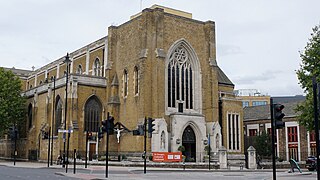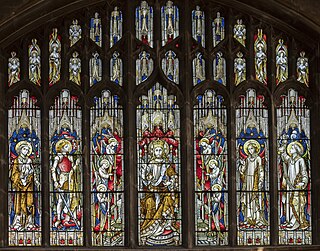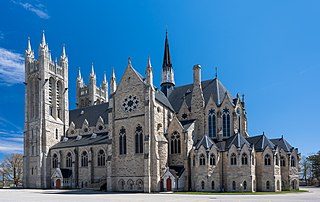
The Metropolitan Cathedral Church of St George, usually known as St George's Cathedral, Southwark, is the cathedral of the Roman Catholic Archdiocese of Southwark, south London, and is the seat of the Archbishop of Southwark.

The Celtic Revival is a variety of movements and trends in the 19th, 20th and 21st centuries that see a renewed interest in aspects of Celtic culture. Artists and writers drew on the traditions of Gaelic literature, Welsh-language literature, and Celtic art—what historians call insular art. Although the revival was complex and multifaceted, occurring across many fields and in various countries in Northwest Europe, its best known incarnation is probably the Irish Literary Revival. Irish writers including William Butler Yeats, Lady Gregory, "Æ" Russell, Edward Martyn, Alice Milligan and Edward Plunkett stimulated a new appreciation of traditional Irish literature and Irish poetry in the late 19th and early 20th century.

Old South Church in Boston, Massachusetts, also known as New Old South Church or Third Church, is a historic United Church of Christ congregation first organized in 1669. Its present building was designed in the Gothic Revival style by Charles Amos Cummings and Willard T. Sears, completed in 1873, and amplified by the architects Allen & Collens between 1935–1937. The church, which was built on newly filled land in the Back Bay section of Boston, is located at 645 Boylston Street on Copley Square. It was designated a National Historic Landmark in 1970 for its architectural significance as one of the finest High Victorian Gothic churches in New England. It is home to one of the oldest religious communities in the United States.

Hardman & Co., otherwise John Hardman Trading Co., Ltd., founded 1838, began manufacturing stained glass in 1844 and became one of the world's leading manufacturers of stained glass and ecclesiastical fittings. The business closed in 2008.

The Honan Chapel is a small Catholic church built in the Hiberno-Romanesque revival style on the grounds of University College Cork, Ireland. Designed in 1914, the building was completed in 1916 and furnished by 1917. Its architecture and fittings are representative of the Celtic Revival movement and evoke the Insular art style prevalent in Ireland and Britain between the 7th and 12th centuries.
The Smith Museum of Stained Glass Windows was an exhibition that opened in February 2000 at Chicago’s Navy Pier entertainment complex. It permanently closed in October 2014. It was the first American museum dedicated solely to the art of stained glass windows.

A revival of the art and craft of stained-glass window manufacture took place in early 19th-century Britain, beginning with an armorial window created by Thomas Willement in 1811–12. The revival led to stained-glass windows becoming such a common and popular form of coloured pictorial representation that many thousands of people, most of whom would never commission or purchase a painting, contributed to the commission and purchase of stained-glass windows for their parish church.

Shrigley and Hunt was an English firm which produced stained-glass windows and art tiles.

Basilica of Our Lady of the Immaculate Conception is a Roman Catholic minor basilica and parish church in Guelph, Ontario, Canada. A Gothic Revival style building constructed between 1876 and 1888 by architect Joseph Connolly, it is considered Connolly's best work. The monumental church contains decorative carving and stained glass executed by skilled craftsmen. The church of Our Lady is one of the 122 parishes in the Diocese of Hamilton and currently has 2,600 families in the congregation.

Old St. Patrick's Church, also known as St. Patrick's Roman Catholic Church and commonly known as Old St. Pat's, is a Roman Catholic parish in Chicago, Illinois. Located at 700 West Adams Street, it has been described as the "cornerstone of Irish culture" in Chicago. The main church building is one of a handful of structures remaining in the city that predate the 1871 Great Chicago Fire, and is the city's oldest standing church building.

The Cathedral Church of Saint Margaret, also known as Ayr Cathedral, is a Roman Catholic cathedral located in Ayr, Scotland. It is the seat of the Bishop of Galloway, and the mother church of the Roman Catholic Diocese of Galloway. St Margaret's was designated a cathedral in 2007, and is the most recent church to be given status as a Roman Catholic cathedral in the United Kingdom, due to the closure of Good Shepherd Cathedral, Ayr.

St. John the Baptist, Blackrock is a Roman Catholic church in the parish of Blackrock, Ireland. The church is still in use and named after the Saint John the Baptist. It is located on Temple Road, Blackrock, County Dublin.

Nathaniel Hubert John WestlakeFSA (1833–1921) was a 19th-century British artist specialising in stained glass.

The Cathedral of St. Brendan, Loughrea, is the cathedral church of the Roman Catholic Diocese of Clonfert. Though designed in neo-gothic style, it arguably houses the most extensive collection of arts and crafts and Celtic Revival artifacts of any single building in Ireland. Its most noteworthy feature is the extensive collection of stained glass windows by the Dublin-based An Túr Gloine studio. There are also twenty-four embroidered banners, mostly depicting Irish saints as well as vestments by the Dun Emer Guild. Sculptors represented are John Hughes (sculptor) and Michael Shortall, and the architect William Alphonsus Scott also contributed designs for metalwork and woodwork. The foundation stone was laid on 10 October 1897 and the structure was completed in 1902; most of the interior features date from the first decade on the twentieth century with the exception of the stained glass windows which continued to be commissioned up until the 1950s.
Catherine Amelia "Kitty" O'Brien was an Irish stained glass artist, and a member and director of An Túr Gloine.

Michael Healy was an Irish stained glass artist, one of a small number which included Wilhelmina Geddes, Evie Hone, and Harry Clarke, who achieved international recognition for their work in this medium in the first half of the 20th century. He also achieved some distinction as an illustrator and cartoonist early on in his artistic career, and as an ongoing recorder of Dublin street characters going about their daily business. Healy also occasionally painted in oil, both portraits and landscapes, exhibiting a small number of the latter during his lifetime.

Louis J. Millet was an educator, industrial art school founder, and interior designer in the United States. He was a celebrated stained glass artist. He worked on Louis Sullivan and George W. Maher projects and went into business with portraitist George Healy at the interior design firm Healy & Millet offering services including interior decoration, floor tiling, and wood mantels. Millet was nationally known for his decorative work, frescoes, and stained glass.

The Church of the Good Shepherd in Rosemont, Pennsylvania, is a progressive Episcopal parish church in the liberal Anglo-Catholic tradition. It is part of the Episcopal Diocese of Pennsylvania and is located in the Philadelphia Main Line.
St. Peter Catholic Church is the first Roman Catholic Church in Montgomery, Alabama, and the third oldest Catholic church in Alabama. It was opened in 1834, but had no resident pastor until 1850. Many of the church's original parishioners were converts from wealthy, educated, Protestant families.

Joseph Edward (Eddie) Nuttgens, in Germany spelt Nüttgens, was a stained glass designer in England who worked mainly on church windows.
















